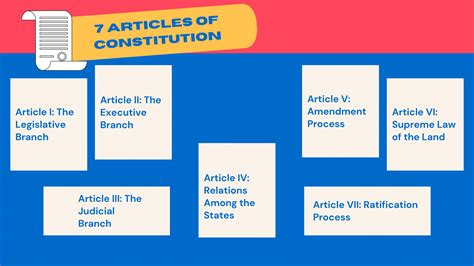Article Vii Of The Constitution Summary

The United States Constitution is a foundational document that outlines the framework and powers of the federal government. It is divided into seven articles, each addressing a specific aspect of the government's structure and function. Article VII of the Constitution is particularly significant as it deals with the ratification process, which is the final step in adopting the Constitution as the supreme law of the land.
Ratification Process

Article VII states that the Constitution would go into effect once nine of the thirteen original states ratified it. This process was deliberately designed to ensure that the Constitution had broad support among the states before it became the law of the land. The ratification process involved each state holding a convention where delegates would debate and vote on whether to approve the Constitution. This approach allowed for a thorough examination of the document’s provisions and facilitated a national discussion about the future of the American government.
Historical Context
The ratification process took place from 1787 to 1788, a period marked by intense debate and negotiation. The Federalist Papers, a series of essays written by Alexander Hamilton, James Madison, and John Jay, played a crucial role in advocating for the Constitution’s adoption. These essays provided detailed explanations of the Constitution’s provisions and addressed concerns about the potential risks and benefits of a stronger federal government. On the other hand, the Anti-Federalists, who opposed the Constitution, argued that it would lead to a tyrannical central government and erode individual liberties.
| State | Date of Ratification |
|---|---|
| Delaware | December 7, 1787 |
| Pennsylvania | December 12, 1787 |
| New Jersey | December 18, 1787 |
| Georgia | January 2, 1788 |
| Connecticut | January 9, 1788 |
| Maryland | April 28, 1788 |
| South Carolina | May 23, 1788 |
| New Hampshire | June 21, 1788 |
| Virginia | June 25, 1788 |
| New York | July 26, 1788 |
| North Carolina | November 21, 1789 |
| Rhode Island | May 29, 1790 |

Key Provisions and Implications

Article VII is concise, consisting of only one section. However, its impact on the formation and operation of the United States government has been profound. The article’s requirement for a supermajority of states to ratify the Constitution ensured that the document had broad support and helped to prevent the imposition of a centralized government on unwilling states. Furthermore, the ratification process set a precedent for future amendments to the Constitution, which must also be approved by a supermajority of states or by a national convention called by two-thirds of the state legislatures.
Comparative Analysis
A comparative analysis of the ratification processes of other countries’ constitutions reveals that the United States’ approach was unique in its emphasis on state-level approval. This decentralized approach reflected the federal nature of the American system and the desire to balance power between the central government and the states. In contrast, many other countries have adopted more centralized approaches to constitution-making, often involving a single national referendum or the approval of a unicameral legislature.
Key Points
- Article VII of the Constitution outlines the ratification process, requiring approval from nine of the thirteen original states.
- The ratification process involved state-level conventions where delegates debated and voted on the Constitution.
- The Federalist Papers played a significant role in advocating for the Constitution's adoption and addressing concerns about its provisions.
- The ratification process took place from 1787 to 1788 and was marked by intense debate and negotiation.
- The Constitution's adoption has had a profound impact on the formation and operation of the United States government, establishing a precedent for future amendments and shaping the country's federal system.
Conclusion and Future Directions
In conclusion, Article VII of the Constitution is a critical component of the document, as it facilitated the transition from the Articles of Confederation to the United States Constitution. The ratification process, with its emphasis on state-level approval and broad support, helped to establish the legitimacy of the federal government and paved the way for the country’s future growth and development. As the United States continues to evolve and face new challenges, the principles enshrined in Article VII remain relevant, serving as a foundation for the country’s federal system and informing the ongoing debate about the proper balance of power between the central government and the states.
What is the significance of Article VII in the Constitution?
+Article VII is significant because it outlines the ratification process, which was necessary for the Constitution to go into effect. The article’s requirement for a supermajority of states to ratify the Constitution ensured broad support and helped to prevent the imposition of a centralized government on unwilling states.
How did the ratification process work?
+The ratification process involved each state holding a convention where delegates would debate and vote on whether to approve the Constitution. This approach allowed for a thorough examination of the document’s provisions and facilitated a national discussion about the future of the American government.
What were the main arguments for and against the Constitution during the ratification process?
+The Federalists, who supported the Constitution, argued that it would provide a stronger and more effective government, while the Anti-Federalists, who opposed it, argued that it would lead to a tyrannical central government and erode individual liberties.
How has the Constitution’s adoption impacted the United States government and society?
+The Constitution’s adoption has had a profound impact on the formation and operation of the United States government, establishing a precedent for future amendments and shaping the country’s federal system. It has also influenced the development of American society, shaping the country’s political culture and informing ongoing debates about the proper balance of power between the central government and the states.
What lessons can be drawn from the ratification process for contemporary constitutional debates?
+The ratification process highlights the importance of broad support and inclusivity in constitutional decision-making. It also underscores the need for careful consideration and debate about the implications of constitutional provisions, as well as the importance of finding a balance between competing interests and values.



